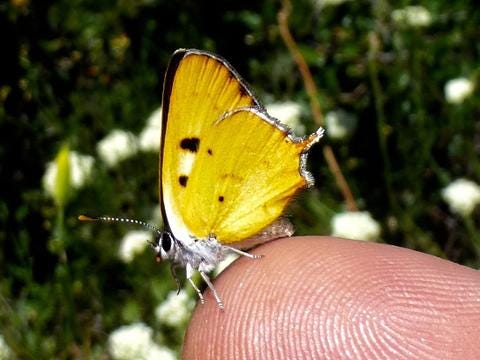News of the week
U.S. Fish and Wildlife Service declares the Hermes copper butterfly Threatened.
This is actually news of last week, which I would have posted had it not been for taking some time off for the holidays.
On Monday, December 20th, the U.S. Fish and Wildlife Service listed the Hermes copper butterfly as Threatened, granting the butterfly protections under the Endangered Species Act.
The Hermes copper is found only in San Diego County and northern Baja, Mexico. In declaring the Threatened status for the butterfly, the U.S.F&WS designates 35,211 acres of critical habitat for the species’ survival.
In all, there were 95 sites among San Diego’s and Baja’s native chaparral and coastal sage where this very small butterfly was known to live. Of those, 45 remain, with 40 sites where the coppers are presumed to be extirpated and 10 where they are permanently extirpated. Development has taken away habitat; fire is also a problem for the butterfly. These insects tend not to wander far; so when a wildfire blazes through their habitat, post-fire recolonization is something the Hermes copper is slow to do—if it recolonizes at all.
Like many other butterflies and moths, the Hermes copper needs a nectar plant that the butterflies can feed on and a host plant on which the caterpillars feed. Females lay their eggs on the spiny redberry plant, an evergreen shrub that is found throughout coastal California and Baja. Once the eggs hatch, the caterpillars feed on the spiny redberry. They feed on no other plant.1 As adult butterflies, they consume the nectar from the flowers of flat-top buckwheat, although it is possible for them to get nourishment from other flowers.
The buckwheat, also an evergreen shrub, is one of the most commonly found plants throughout the coastal sage and chaparral of southern California. I see it almost always during my hikes around San Diego County. I see spiny redberry more sporadically. Some canyons and foothills have a lot of it, while it might be completely absent from other areas.
Historically, the coastal sage and chaparral burned with some regularity, and these plant communities are adapted to surviving fires that recur from 20 to 160 years. Spiny redberry resprouts quickly after wildfire and is relatively resilient to frequent burns. Things are more complicated for the flat-top buckwheat. It does not resprout after being burned, but—if conditions are right—has been known to recolonize quickly after a fire. And here is the thing to remember about the buckwheat, conditions are not always ideal for it to recolonize.
With lots of people living in San Diego and northern Baja, there are lots of sources of ignition: power lines, sparks from machinery, lit cigarettes tossed out of car windows. Fires have become more frequent, which can degrade the habitat quality for the Hermes copper. Worst of all, if the fires recur more quickly, again and again, the habitat can be lost permanently, as the native chaparral and coastal sage habitats convert into expanses of nonnative grasses.2
Further complicating the butterfly’s recovery, is that there is a lot that is not understood about the Hermes copper. There are places in the County that have plenty of spiny redberry and buckwheat, but the butterflies are nowhere to be found. And no one really knows why.
As far back as 100 years ago, the tenuous existence of the Hermes copper was recognized. In the 1920s, butterfly enthusiast John A. Comstock said of the copper, “It will always be a rarity, and may, in fact, some day become extinct, if San Diego continues to expand at its present rate.”
In 1980, naturalists at the San Diego Natural History Museum noted the precarious status of the Hermes copper, saying:
[W]ith San Diego's increasing growth and the distributional nature of this little endemic butterfly, its future may well rest in the hands of developers. Hermes copper butterfly is threatened by megafires, habitat fragmentation, and the effects of restricted range and small population size throughout all of the known populations in the United States. The effect of past habitat fragmentation is considered irreversible and has continuing impacts over the range of the species.3
In 1991 and 2004, the Center for Biological Diversity and the San Diego Biodiversity Project filed formal petitions with the federal government to protect the butterfly. In 2003 and 2007, huge wildfires raged through San Diego County. (I’ll have more to say about those fires on Monday.) The wildfires of 2003 destroyed 19 Hermes copper populations and about 39 percent of their habitat. Despite the loss of habitat, in 2011 the USF&WS, under the Obama administration, denied protection for the Hermes copper.4
Sprawl has continued to plague the copper. In March of 2012, due to a legal action by a troika of environmental groups—the Center for Biological Diversity, Preserve Wild Santee, and the Endangered Habitats League—a court upheld a challenge to a sprawling 2,600 acre development in the foothills of San Diego County that would have seen the construction of 1,400 housing units. The judge said that the project failed to adequately address fire safety.5 Presently, the large development seems like it may still be in the making, although the Hermes copper’s new federal Threatened listing may put that in jeopardy.
For more environmental news follow me on Twitter @EcoScripsit.
In the last four or five years I may have read that some scientists think the Hermes copper might be evolving to feed on other host plants, but when I try to find the source, nothing turns up. If anyone has further information on this, please let me know.
This process of frequent fires turning chaparral and costal sage into nonnative grasslands is called “type conversion.”
"Southern California Butterfly Denied Endangered Species Protection." Targeted News Service, 14 Apr. 2011. Gale OneFile: News, link.gale.com/apps/doc/A254020345/STND?u=sddp_main&sid=bookmark-STND&xid=e7d369cb. Accessed 30 Dec. 2021.
"Southern California Butterfly Denied Endangered Species Protection." Targeted News Service, 14 Apr. 2011. Gale OneFile: News, link.gale.com/apps/doc/A254020345/STND?u=sddp_main&sid=bookmark-STND&xid=e7d369cb. Accessed 28 Dec. 2021.
"Fanita Ranch Fails Second Test: Court Rules City of Santee Has Still Not Addressed Development's Fire Safety." Targeted News Service, 2 Mar. 2012. Gale OneFile: News, link.gale.com/apps/doc/A281785400/STND?u=sddp_main&sid=bookmark-STND&xid=d555e321. Accessed 30 Dec. 2021.





